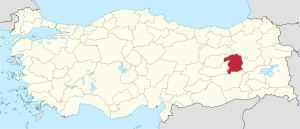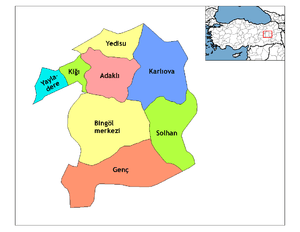Bingöl Province
Bingöl Province (Turkish: Bingöl ili; Zazaki: Suke Çolig,[2] Kurdish: Parêzgeha Çewlîgê,[3][4] Armenian: Ճապաղջուր, romanized: Chapaghjur) is a province of Turkey in Eastern Anatolia. The province was created in 1936[5] out of parts of Elazığ and Erzincan. The new province was known as Çapakçur Province (from the Armenian name "Chapaghjur," meaning "rough waters") until 1945 when it was renamed as Bingöl province.[5] Its neighboring provinces are Tunceli, Erzurum, Muş, Diyarbakır, Erzincan and Elazığ. The province covers an area of 8,125 km2 and has a population of 255,170. The main spoken languages are Turkish, Zazaki and Kurdish. The capital is Bingöl. The majority of the province's population is Zazas.[6][7] As the current Governor of the province, Kadir Ekinci was appointed by the president on the 5 November 2018.[8]
Bingöl Province Bingöl ili | |
|---|---|
 Location of Bingöl Province in Turkey | |
| Country | Turkey |
| Region | Central East Anatolia |
| Subregion | Malatya |
| Government | |
| • Electoral district | Bingöl |
| • Governor | Kadir Ekinci |
| Area | |
| • Total | 8,125 km2 (3,137 sq mi) |
| Population (2018)[1] | |
| • Total | 281,205 |
| • Density | 35/km2 (90/sq mi) |
| Area code(s) | 0426 |
| Vehicle registration | 12 |
History
In December 1935 the Tunceli Law was passed which demanded a more powerful government in the region.[9] Therefore the region containing the present Bingöl province, together with the provinces of Tunceli, Erzincan and Elaziğ were included in the Fourth Inspectorate General (Umumi Müfettişlik, UM) in January 1936.[10][11] The fourth UM was governed by a Governor Commander. All the employees in the municipalities were to be from the military and the Governor Commander had the authority to evacuate whole villages and resettle them in other parts of the province.[10] in 1946 the Tunceli Law was abolished and the state of emergency removed but the authority of the fourth UM was transferred to the military.[10] The Inspectorate General was dissolved in 1952 during the Government of the Democrat Party.[12]
Districts
Bingöl province is divided into 8 districts (capital district in bold):
References
- "Population of provinces by years - 2000-2018". Turkish Statistical Institute. Retrieved 9 March 2019.
- Zazaca -Türkçe Sözlük, R. Hayıg-B. Werner
- "Li 26 herêmên Çewlîgê "herêmên ewlehiya taybet" hat ragihandin". Rûdaw. 11 November 2018. Retrieved 27 April 2020.
- "Genç - Bingöl". Municipality of Bingöl (in Zazaki and Turkish). Retrieved 28 April 2020.
- "Valilik Tarihçesi". www.bingol.gov.tr. Retrieved 2020-04-12.
- Zaza people not kurd and turk
- Watts, Nicole F. (2010). Activists in Office: Kurdish Politics and Protest in Turkey (Studies in Modernity and National Identity). Seattle: University of Washington Press. p. 167. ISBN 978-0-295-99050-7.
- "Valimiz". www.bingol.gov.tr. Retrieved 2020-04-12.
- Cagaptay, Soner (2006-05-02). Islam, Secularism and Nationalism in Modern Turkey: Who is a Turk?. Routledge. pp. 108–110. ISBN 978-1-134-17448-5.
- Bayir, Derya (2016-04-22). Minorities and Nationalism in Turkish Law. Routledge. pp. 139–141. ISBN 978-1-317-09579-8.
- Cagaptay, Soner (2006-05-02). Islam, Secularism and Nationalism in Modern Turkey: Who is a Turk?. Routledge. p. 110. ISBN 978-1-134-17448-5.
- Fleet, Kate; Kunt, I. Metin; Kasaba, Reşat; Faroqhi, Suraiya (2008-04-17). The Cambridge History of Turkey. Cambridge University Press. p. 343. ISBN 978-0-521-62096-3.
External links
| Wikimedia Commons has media related to Bingöl Province. |
- (in Turkish) Bingöl governor's official website
- (in Turkish) Bingöl municipality's official website
- Bingöl weather forecast information
- (in Turkish) Bingöl and Solhan local news website
